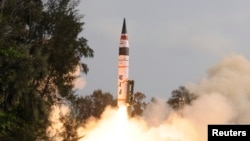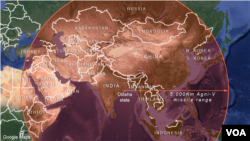India has successfully carried out a fourth test of its nuclear-capable, intercontinental Agni-V missile, which can hit targets more than 5,000 kilometers away, effectively putting China's northernmost areas within range of Indian nuclear weapons.
The 17.5-meter-long, 50-ton surface-to-surface missile was test fired Monday from Abdul Kalam Island, off the coast of the eastern Odisha state, and splashed down near Australian waters.
Ajay Lele, at New Delhi’s Institute for Defense Studies and Analyses, says the test ensured the Agni-V missile is operational.
“After this, the missile will be handed over for the operationalization of it to India’s strategic forces command and they will undertake two tests and subsequently the missile will come into India’s armory,” said Lele.
Longer range
Earlier generations of Agni missiles, developed over the last decade, are capable of striking anywhere in Pakistan, India's neighbor and South Asian rival. The two countries have fought three wars and tensions continue to run high. Pakistan also possesses nuclear weapons.
Defense analysts say the longer-range Agni-V missile has been developed with an eye on China, which New Delhi also views as a threat.
India and China fought a brief war in 1962 and have an unresolved boundary dispute in the Himalayas. New Delhi also remains wary of China’s close ties with Islamabad and bid to increase its influence in the Indian Ocean.
The Agni missile adds considerable heft to India’s nuclear capability and its aspirations to be viewed as a regional power. Only China, France, Russia the United States and Britain have long-range nuclear weapons.
Scientists said the latest missile incorporates new technology for navigation and guidance.
Indian leaders welcomed the successful test of the Agni, which means "fire" in Hindi and Sanskrit.
Congratulating the scientists, Prime Minister Narendra Modi tweeted that the “[s]uccessful test firing of Agni-V makes every Indian very proud. It will add tremendous strength to our strategic defense.”
The missile was launched from a mobile platform, which gives the armed forces flexibility to transport and fire it swiftly from anywhere they want.
However, Lele noted that India's nuclear doctrine emphasizes a “no-first-use” policy and that New Delhi’s official position is that its nuclear deterrence is not country-specific.
“It is essentially to make a point that yes, we have a sufficient amount of arsenal. If somebody attacks us by using nuclear weapons, we can respond effectively,” he said.








